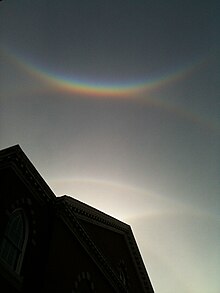Circumzenithal arc

The circumzenithal arc or circumzenith arc (CZA), also called the Bravais' arc, is an optical phenomenon similar in appearance to a rainbow, but it belongs to the family of halos arising from refraction of sunlight through ice crystals, generally in cirrus or cirrostratus clouds, rather than from raindrops. The arc is located at a considerable distance (approximately 46°) above the sun and at most forms a quarter of a circle centered on the zenith. It has been called "a smile in the sky", its first impression being that of an upside-down rainbow. The CZA is one of the brightest and most colorful members of the halo family. Its colors, ranging from violet on top to red at the bottom, are purer than those of a rainbow because there is much less overlap in their formation.
Contrary to public awareness, the CZA is not a rare phenomenon (it occurs much more often than rainbows), but it tends to be overlooked since it occurs so far overhead. It is worthwhile to look out for it when sun dogs are visible, since the same type of ice crystals that cause them (plate-shaped hexagonal prisms in horizontal orientation) are responsible for the CZA.[1]
Formation
The light that forms the CZA enters an ice crystal through its flat top face, and exits through a side prism face. The refraction of almost parallel sunlight through what is essentially a 90-degree prism accounts for the wide color separation and the purity of color. The CZA can only form when the sun is at an altitude lower than 32.2°.[2] The CZA is brightest when the sun is at 22° above the horizon, which causes sunlight to enter and exit the crystals at the minimum deviation angle; then it is also about 22° in radius, 3° in width. The CZA radius varies between 32.2° and 0° depending on the solar altitude. Towards either of the extremes it is vanishingly faint. When the sun is above 32.2°, light exits the crystals through the bottom face instead, to contribute to the almost colorless parhelic circle.
Because the phenomenon also requires that the ice crystals have a common orientation, it occurs only in the absence of turbulence and when there is no significant up- or downdraft.[3]
Lunar circumzenithal arc
As with all halos, the CZA can be caused by light from the moon as well as from the sun: the former is referred to as a lunar circumzenithal arc.[4] Its occurrence is rarer than the solar variety, since it requires the moon to be sufficiently bright, which is typically only the case around full moon.
See also
References
- ^ http://www.atoptics.co.uk/halo/czaform.htm
- ^ http://www.atoptics.co.uk/halo/czasalt.htm
- ^ Stokel-Walker, Chris (18 January 2016). "Who, What, Why: How common are upside-down rainbows?". BBC News Online. Retrieved 18 January 2016.
- ^ http://www.atoptics.co.uk/fz793.htm
- David K. Lynch and William Livingston. Color and Light in Nature. 2nd ed, 2004 printing.
- Les Cowley. "Circumzenithal Arc". Atmospheric optics. Retrieved 2007-04-23.
- Les Cowley. "CZA - Effect of solar altitude". Atmospheric Optics. Retrieved 2007-04-23.
External links
- Atmospheric Optics - About CZAs
- Atmospheric Optics - Circumzenithal Arc Gallery
- Circumzenithal arc over Rome, Italy
- Timelapse video of weak Circumzenithal Arc
- Physics of the circumzenithal arc
- Images from the UK by Crayford Manor House Astronomical Society
- Circumzenithal Arc Over Frisco, TX | 1-23-11 | Clouds 365 Project - Year 2
- Spaceweather.com Atmospheric optics expert Les Cowley created a diagram labeling the halos
